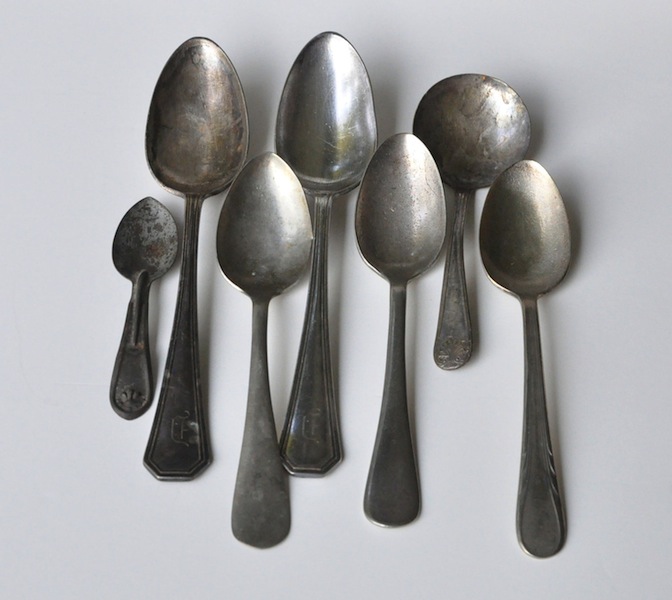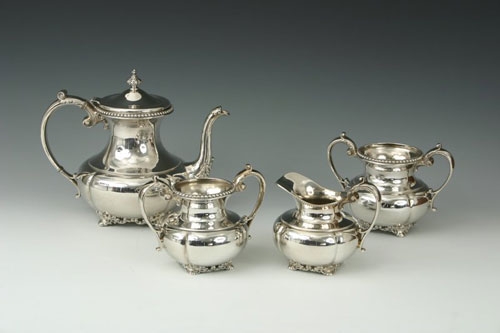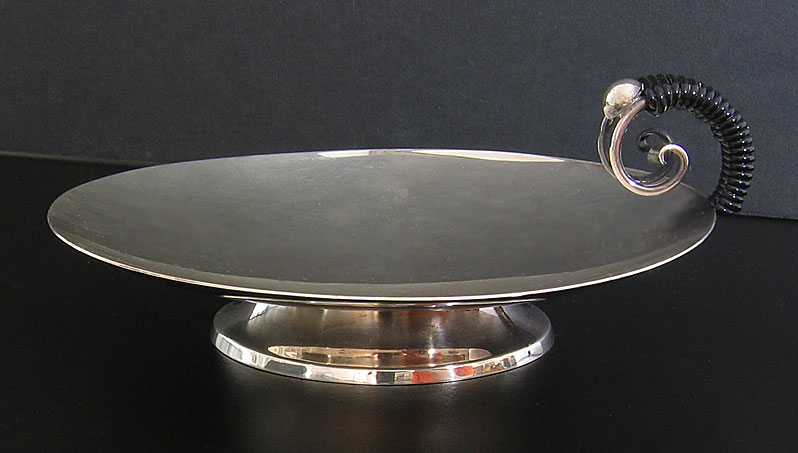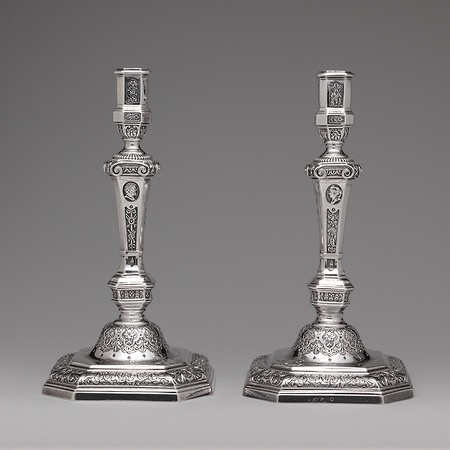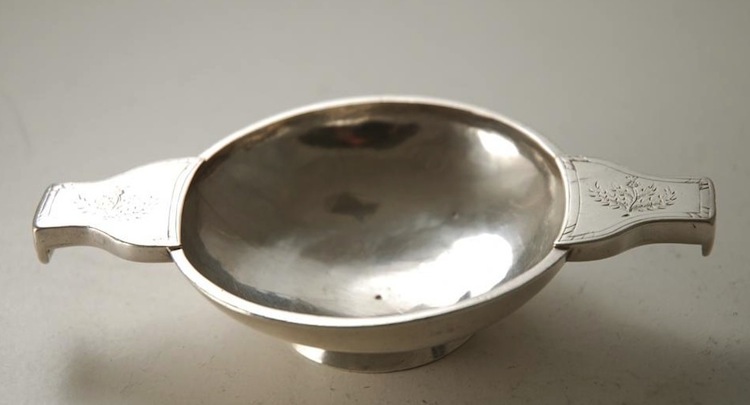Despite the vagaries of fashion, old silver has remained one of the most enduringly popular collecting areas, and if you know what to look for, there are plenty of affordable finds out there.
From the earliest times, silversmiths realised that pure silver was unworkably soft, and had to be mixed with other, more resilient base metals before it could be made into objects.
A silver standard was introduced in Britain in 1300 and all silver objects made after this date had to be tested and marked to show they contained more than 92.5 per cent pure silver. This marking system has survived in Britain and Ireland with few modifications to the present day. Marks provide the collector of English silver with an invaluable aid.
You may come across silver with fake or altered marks, or unmarked pieces, but these are relatively scarce, and once you have learned to ‘read’ the marks, you will be able to identify where, when and – often – who made most pieces of sliver. Nonetheless, you should always take into account the style of a piece to make sure it’s consistent with the date of the marks. Much Continental and American silver was also marked in some way, although in many countries the system was less rigorously applied than in England.
Old silver pieces remain consistently collectable
Despite changing fashions, old silver pieces remain consistently collectable. Small 19th-century objects are still available for £100 or less, and old Sheffield plate and electroplate also offer excellent value.
Hallmarks
There are four main marks.
Sterling guarantee mark. Silver that is at least 92.5 per cent pure is termed ‘sterling’ silver. All silver objects of sterling quality were stamped with a leopard’s head from 1300. By 1458 the leopard had a crown; from 1544 the sterling mark changed to a lion passant, shown walking to the left (after this date the leopard’s head was used as the London town mark). Between 1697 and 1720, a higher standard of silver, known as the Britannia standard, was introduced. During this period the sterling mark was replaced by a figure of Britannia, and a lion’s head in profile
Town marks. Marks showing the town of assay were introduced by the end of the 15th century. Some of the commonest are:
Date letters. Marking with a date letter, which changed each year, was introduced in the 15th century in London, and later in other parts of the country. The letters usually follow an alphabetical sequence, but are antique to each assay office. The letter is contained within a shield.
Maker’s mark. Marks to show the identity of the maker were used from the 14th century. The earliest were pictorial symbols, but from the late 17th century marks increasingly incorporated the silversmith’s initials.
Altered and faked marks
Forged marks. Fake marks are usually less clearly defined than genuine ones; if they’ve been made by recasting a genuine piece there may be small granulations visible in the outline.
Transposed marks. Marks are sometimes taken from a low-value object and inserted in a larger, potentially more valuable one. If you breathe on transposed marks you should be able to see a faint outline around the marks where they were soldered in.
Illegal alterations. An act of 1844 made it illegal to alter any piece of silver without hallmarking the additions. However, many pieces were updated to make them more useful, or more fashionable, rather than to deliberately deceive.
Patina
Over years of use, silver develops a soft glow, or patina, caused by accumulated scratching and knocks and bruises. This patina is important to value. Repolishing old silver on a buffing wheel can destroy the patina of a piece and is usually undesirable.
Weight
Although an item which is heavier than average may not appear larger or heavier, extra weight is usually synonymous with quality, and heavier pieces tend to be more valuable.
Styles and decoration
Silver styles reflect the taste of the period, and can often provide a good indication of date. Decoration may be applied to the surface or the border of a piece and usually adds to value.
Condition
Repairs are usually detrimental to value. If lead has been used in the repair it can be especially unsightly. Areas particularly vulnerable to damage are:
- Feet – these can be pushed up through the base with time
- Handles – the metal of the body may be pulled away by the handle
- Hinges – can be broken and are often difficult to repair
- Pierced decoration – may be relatively fragile and prone to damage
Silver plating
Sheffield plate. Made from a fusion of copper and silver, this was introduced c.1740. Most is unmarked, although some early 19th-century pieces had marks very similar to those found on silver. A piece with ‘Sheffield plate’ stamped on it is electroplate made in Sheffield in the 19th century, not genuine Sheffield plate. Sheffield plate tends to be much less expensive than silver, but the best pieces are keenly collected.
Electroplate. This method, involving covering a base metal with a thin layer of silver by electro-deposition, was used from c.1840. The base metal was initially copper, but later nickel was used, hence the term EPNS (electroplated nickel silver). Electroplate is usually marked by its maker, or bears indications of quality. Apart from pieces by an eminent maker such as Elkington, electroplate is less collectable than other types of silver.
Caddies and casters
Don’t be shocked by the extravagance and cost of antique caddies – tea was once so costly it was drunk only in the wealthiest homes, and the caddies for storing this precious commodity were intended as objects for display as much as for storage. Nowadays, caddies are keenly collected – and the best ones can be expensive.
Caddies
Caddies were usually kept in the drawing room. Some had detachable caps for measuring the tea, while others were even fitted with lock and key to protect their precious contents from dishonest servants.
The caddy at the top of the page is worth £2,500 to £3,500. It has three key features you should look for on other pieces:
- high-quality decoration
- a maker’s mark
- date marks of the 18th century (19th-century caddies are usually less valuable)
Caddy sets
Sets of caddies always command a premium. This set of two caddies and a sugar box would be particularly valuable because each piece has its original arms and it comes with its fitted box. It’s worth around £8,000 to £12,000.
Marks
Caddy bodies and lids should have a full set of hallmarks, although early 18th-century caddies with detachable lids, such as this one, are often unmarked on the cap. This sort of caddy is worth about £2,000 to £3,000.
Casters
Made to hold sugar, pepper and dry mustard, casters played an essential role in fashionable dining rooms when liberal quantities of spices and seasonings were essential to disguise the flavour of stale food.
Early casters had straight sides. Baluster-shaped casters like this one were made from about 1705, with designs becoming taller during the century. Most were originally made in pairs or sets and today these are always particularly sought-after. Better quality ones, such as this, have elaborately pierced covers. This is one of a set of three made by David Tanqueray in 1713 and is worth over £3,000.
Candlesticks
We may no longer depend on candlelight for illumination, but nothing graces a dining table more elegantly than a pair of silver candlesticks. There are many different types to choose from, and many factors to look out for to make sure you’re getting the best deal
Most candlesticks and candelabra were originally made in pairs or larger sets. Expect to pay more than double for a pair of candlesticks than for two single ones – even if they’re the same design and size! To be a true pair, candlesticks must be made by the same maker at more or less the same date.
The picture above is of a typical mid-18th-century candlestick, which was made by casting the separate sections – base, stem and sconce – in moulds. Cast candlesticks are usually more desirable than ‘loaded’ ones, which were made from thin sheets of silver filled with pitch to give weight. Cast ones are worth more than £3,000 a pair.
What to look for
Nozzles – should have the maker’s mark and lion passant.
Sconce – if the seams on the stem and sconce aren’t aligned, the candlestick has been heavily repaired. On the candlestick above you can see the lion passant mark on the sconce.
Stem – during the 18th century, stems became progressively taller. Early candlesticks rarely measure more than 13cm (7in); this mid-18th century one is 25cm (10in).
Base – sheet candlesticks are marked in a line above the base, cast ones are marked in the well or under each corner.
Chamber candlesticks
These were used to light the way to bed and, unlike other candlesticks, are usually sold on their own rather than in pairs. This one was made in the 1780s and like many is fitted with a snuffer. Worth £1,000 to £1,500.
Candelabra
The separate parts are frequently replaced – four nozzles on this pair are replacements. However, these candelabra were made by John Scofield, an eminent 18th-century maker, so the price would still be more than £15,000.
Flatware
Knives, forks and spoons are usually termed “flatware” by silver collectors. They can be bought as complete sets or piece by piece; whichever you choose, make sure you’re aware of the most valuable patterns and any factors that can decrease their value.
There are many ways of collecting flatware, depending on your budget. Complete services, which usually comprise settings for 12, may seem prohibitively expensive, but odd numbers of spoons and forks in the most common patterns – such as Old English, Fiddle or Hanoverian – are relatively easy to find and it’s often far less costly to build up a service piecemeal.
Flatware services don’t usually include knives. These often had thin metal handles which may become worn; most collectors prefer reproductions, which are more robust.
The date of flatwares can affect their price even more dramatically than other types of silver.
Apostle spoons
These get their name from their handles, which are decorated with a figure of an Apostle (see main picture, above). They are among the most valuable spoons and are sometimes faked by reshaping ordinary 18th-century spoons. You can spot these by the stiffness of the figure. Worth more than £1,000.
Patterns
Different patterns are identifiable by their names. Here are some of the most popular, which have been repeated continually since they were first made.
- Rat-tail
- Old English
- Fiddle thread
- Beaded
- Albany
Old English pattern
The most desirable services contain a dozen tablespoons, table forks, dessert spoons, dessert forks and teaspoons. This 77-piece Old English pattern service has the added bonus of a basting spoon and other serving pieces, which increases its value. Worth £6,000 to £8,000.
Wear and tear
Badly worn flatwares are virtually impossible to restore and are worth only scrap value. Only the fork on the left is in good condition. The one in the centre is badly worn; the other has been trimmed to disguise the damage.
Miscellaneous silver
If you want to collect on a modest budget, small novel objects made from silver can provide an ideal way to start. Objects available include pin cushions, card cases, nutmeg graters, vinaigrettes, snuff boxes, sewing cases, glove stretchers and letter openers – to name but a few!
Look carefully in the display cabinet of a general antique shop or at a silver auction and you’re likely to find many small collectable silver objects. Many of these pieces will display Birmingham’s anchor hallmark, as silversmiths in this area produced such small silver items in their thousands from the late 18th century. The least expensive pieces tend to be those produced during the 19th century; earlier objects are scarcer and can be highly priced.
Snuff boxes and vinaigrettes
The decoration of small snuff boxes has a huge bearing on their price. Hunting scenes are particularly sought after; the silver gilt snuff box at the top of the page, made in 1828, would be worth more than £1,500.
Vinaigrettes were used to contain aromatic salts, vinegar or perfume and are smaller than snuff boxes, although equally in demand. They’re worth £1,000 to £1,500.
What to look for:
- Check the point where the handle joins the body to make sure it’s secure.
- Examine the hinge on the lid to make sure it’s not weak or restored.
Beware – snuff boxes are sometimes turned into vinaigrettes by adding grilles, and vice versa. This reduces their value considerably. This example is worth only £200.
Mirrors
Like most silver-framed mirrors, this one is part of a set of dressing-table silver. The unusually fine quality is reflected in the price – more than £100,000 for the set!
During the late 19th, early 20th century less expensive mirrors were made from wooden frames covered with velvet and decorated with die-stamped silver. These are often badly worn and difficult to clean, but still highly sought after.
Die stamping
Die-stamped silver is patterned by pressing solid metal moulds together on either side of sheet silver. This technique made it relatively inexpensive to mass-produce elaborate decoration and was much used in the 19th century.
Art nouveau
Silver items reflecting the art nouveau style, marked by well-known makers or retailers, are becoming increasingly collectable. This box, with its typical art nouveau motif on the lid, was made for Liberty & Co and would be worth £700 to £1,000.
Glass and silver
The combination of glass and silver has produced some highly decorative objects, but before buying make sure the glass isn’t broken – it can be costly to replace, especially if shaped. This 1911 Ramsden & Carr silver and enamel case contains its original glass bottle and is worth more than £2,000.
Silver decoration
Small silver pieces are decorated in a wide variety of ways. Some of the most common terms used to describe the techniques include:
- bright cutting – a type of faceted engraving
- chasing or embossing – patterns made by hammering or punching
- cut-card decoration – flat shapes added to rims etc
- filigree – open wire panels decorated with little silver beads

